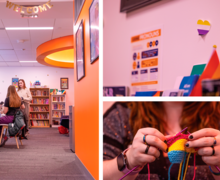Lockheed Martin plant in Syracuse awarded contract from the US Navy
Daily Orange File Photo
Aerospace company Lockheed Martin’s plant in suburban Syracuse has received a $148.9 million contract for electronic warfare defenses for its ships
The United States Navy recently awarded global security and aerospace company Lockheed Martin’s plant in suburban Syracuse a $148.9 million contract for electronic warfare defenses for its ships. The contract was allocated for the production of the Surface Electronic Warfare Improvement Program Block 2.
Melissa Chadwick, media relations manager at Lockheed Martin, said under this full-rate production contract, Lockheed Martin’s engineers will provide additional systems to upgrade systems on U.S. aircraft carriers, cruisers, destroyers and other warships with key capabilities to determine if the electronic sensors of potential foes are tracking the ship.
“Basically, SEWIP allows sailors to protect the ship from the threats you can see, like enemy aircraft, and threats you can’t see, like modern anti-ship cruise missiles,” Chadwick said. “Imagine having full use of your abilities to detect, track, and engage opponents — all while clouding their abilities to strike at — or even sense — you.”
Lockheed Martin’s plant at Electronics Park in Liverpool previously received contracts to provide more than $350 million in electronic defense upgrades to aircraft carriers, cruisers, destroyers and other Navy ships as part of the Block 2 phase of SEWIP, according to a Syracuse.com article.
About 23 percent of the work on the new contract will be performed on Lockheed’s campus in Salina, according to the Syracuse.com article. About 1,600 people are employed at the Electronics Park location and the work is expected to be completed by November 2019.
“The SEWIP Block 2 System is critically important to the Navy’s operation, and we are proud to continue to provide this capability to the warfighter,” said Joe Ottaviano, electronic warfare program director at Lockheed Martin, in a press release.
Vice Adm. Robert Murrett, deputy director of the Institute for National Security and Counterterrorism at SU, said Electronic Warfare systems were vital for the Navy because it is a military service that depended upon operating electronically.
Chadwick added the contract from the Navy means Lockheed Martin will be continuing its strong history of building systems that help the U.S. Navy safely patrol and protect the seas.
“These technologies provide real-time situational awareness, enabling the U.S. Navy to intercept signals that identify both imminent and potential threats,” Chadwick said. “Our electronic warfare systems span air, land and sea, equipping sailors, pilots and soldiers with the tools they need to outpace the enemy.”
Lockheed Martin has a proud history of operations in Syracuse, Chadwick said. In Syracuse, she said, Lockheed Martin was primarily involved in the development and production of situational awareness technology for a broad range of domestic customers and more than 40 international countries.
These systems informed critical decisions made by national leaders, troops on the battlefield, intelligence agents and emergency responders, Chadwick added.
Published on October 11, 2016 at 10:09 pm
Contact Deniz: dsahintu@syr.edu





